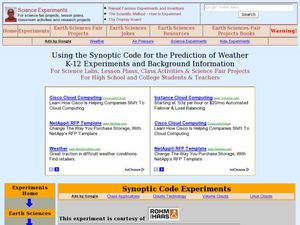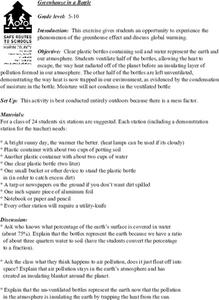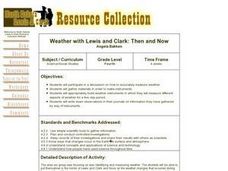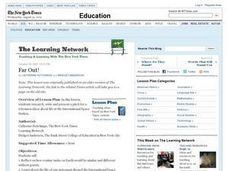Curated OER
What Goes Around Comes Around
Students investigate how the ocean plays a part in the water cycle. In this earth science lesson, students locate a puddle outside and mark it with chalk. Students observe the changes in the water during the next two days.
Curated OER
Student Exploration: Summer and Winter
In this recognizing the seasons online/interactive instructional activity, students explore the Earth's positions and determine the summer and winter season. Students answer 21 short answer questions
Curated OER
Agriculture is a Cycle
Students explore cycles in nature. In this cross curriculum agriculture lesson, students define "cycle" and research weather and planting folklore. Students make a bracelet in which individual colored beads represent the many "cycles" of...
Curated OER
The Environment and You
First graders examine the human environmental impact and discover ways to lessen effects. They create a pollution damage flow chart and write down what they think Mother Earth might say. They create inventions from recyclable materials.
Curated OER
Prehistoric Discoveries
Students agree or disagree with several statements about ancient animals, then read a news article about recent prehistoric discoveries. In this earth science and current events lesson, the teacher introduces the article with a...
Curated OER
What Makes a Home "Energy Efficient"?
Students research and report the costs and benefits of making their own homes more energy efficient. In this energy conservation lesson, students explore energy efficient technologies and design over several days. They complete a home...
Curated OER
Clouds
Students explore basic cloud types and the weather associated with each one. In this earth science lesson, students participate in numerous activities including going outside to observe the clouds they see, making a cloud in a jar,...
Curated OER
The Weather
Students explore earth science by reading articles in class. In this weather identification lesson, students analyze weather science articles on the Internet and view their own local weather patterns as well. Students define a list of...
Curated OER
Sunlight and Warm Air
Students examine the different ways heat can be felt. In this radiation and conduction lesson, students recognize that the sun radiates heat. Students conduct three experiments to find how the sun warms the Earth and how that heat is...
Curated OER
Using the Synoptic Code for the Prediction of Water
Students construct a thermoscreen for the experiment. In this earth science instructional activity, students make observations and interpret them using synoptic codes. They predict the weather based on gathered information.
Curated OER
Greenhouse in a Bottle
Students create models of the greenhouse effect using recycled 2-liter bottles. They discuss how their models compares to the real greenhouse effect the earth experiences.
Curated OER
Watershed Lesson Plan
Students are introduced to the concepts of a watershed, stream flow and water quality. This five-day plan is an excellent way to introduce students to the concepts involved. They create their own watershed using a paper bag, water and...
Curated OER
Solar Energy Experiment
Young scholars observe solar energy at work. In this science lesson, students watch two bottles, painted black and white, sit in the heat with balloons on the mouth of the bottles. They observe and discuss why the balloon of the black...
Curated OER
Sunspots and the Sun's Rotation
For this sun worksheet, learners use a Sunspotter to observe the rotation of the sun by identifying the presence of sunspots and watching them rotate over time. Students calculate how many days it takes to see the sunspots they observe...
Curated OER
Sampling Rocks
Students investigate rocks. In this earth science lesson, students collect rocks from the schoolyard and describe each of the rocks. Students measure and weigh each rock and record the results. Students create a rock guide for the...
Curated OER
Weather with Lewis and Clark: Then and Now
Fourth graders discuss how to accurately measure weather, gather materials in order to make instruments, and build weather instruments in which they measure and record different aspects of weather for a five-day period.
Curated OER
Far Out!
Students research and compare/contrast how routine tasks on Earth would be without gravity. They read and discuss the article "The Life Galactic: A Lot of Work, a Little Play, Plenty of E-Mail." In groups they write a pitch for a TV...
Alabama Learning Exchange
A Rockin' Investigation
Young scientists identify the rock cycle. In this earth science activity, students participate in web-based research to understand how sedimentary, metamorphic, and igneous rocks form. As a follow-up, they collect various rocks and...
Curated OER
Writing the Wind
Students make a windmill. In this wind lesson, students learn background information about the windmill, complete an activity where they create a windmill, discuss using wind as a natural resource and brainstorm other inventions that...
Curated OER
An Environmental Puzzle: The Carbon Cycle
Young scholars are introducced to how respiration and photosysnthesis cycle carbon through ecosystems. They read background information that describes the role of the Sun as Earth's ultimate energy source and explains how the energy...
Curated OER
Fitting In-Animals' Adaptations to Their Environment
In this animals' adaptation to their environment learning exercise, students read for comprehension and ability to apply knowledge. In this T-Chart and creative activities learning exercise, students answer three questions.
Curated OER
Moon: NC Summer Tour Lesson 2007
Students investigate craters and marea. In this crater and marea instructional activity, students conduct an experiment to create craters. Students participate in a dance activity.
Curated OER
Rock Hounds
Students receive a basis for understanding the three main classifications of rock: igneous, sedimentary and metamorphic. They engage in a hands-on activity designed to give them an appreciation for rocks and minerals.
Curated OER
Nomad Land
Learners explore the migratory movements of animals as they monitor their own movements throughout the school day. Climatic and feeding conditions are examined as cues for the movement.

























